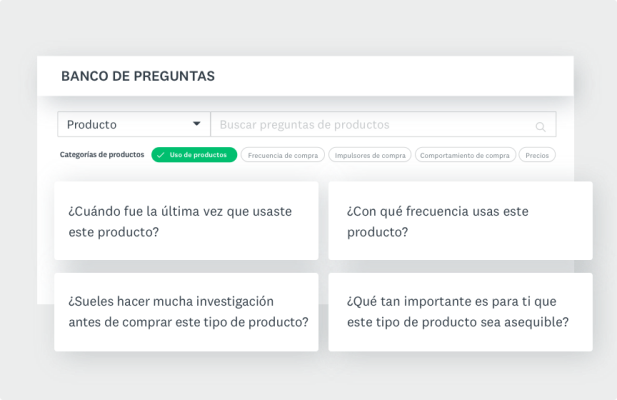More Resources
Why do 95% of product launches fail?
Product launches, marketing messages, and ideas flop because companies did not identify or failed to reach their target audience. How can marketers improve the odds of getting their products and services seen by the right audience?
The market segmentation definition describes how companies group people into unique market categories, often using marketing research surveys to define their needs. After analyzing these market segments, companies will perform customer segmentation to describe different types of buyers.
Age, occupation, gender and other demographic data are common ways to segment customer groups. Companies can also describe their target market by defining their buying behaviors, known as behavioral segmentation. The definition of behavioral segmentation is grouping buyers based on their real-life behaviors, not just their general demographic traits. This form of customer segmentation can be more effective than demographics, psychographics, and other segmentation methods.
SurveyMonkey’s Consumer Segmentation solution makes it easy to profile and segment your target audience.
What is behavioral segmentation?
Consumers have more product choices than ever before. For instance, today’s larger grocery stores have 80% more individual items than they did 30 years ago. This product proliferation has expanded consumer choices, making it more difficult to make a purchase. It has never been more critical for companies to understand how their buyers make simple or even complex purchase decisions.
Because there are so many products, sellers need their products to stand apart from their competitors. They must define their market segmentation approach. What is market segmentation? It is a method that companies use to identify their target market and develop messaging to help them navigate the sea of product choices.
Companies use market segmentation surveys to identify demographic, psychographic, and geographic approaches to hone in on their target market. However, these approaches assume that everyone with those characteristics will act the same way. Will all 50-year olds buy the same kind of orange juice? Will all 20-year olds buy the same shampoo? Marketers can also perform behavioral segmentation to identify their market's unique buying habits and make their products stand apart from their competitors.
Behavioral market segmentation describes specific steps in their ideal customer’s buying process, including what their ideal customers want, why they want it, the benefits sought, and how they go about getting their needs met. Through market research, companies learn what steps buyers take to gain awareness, buy products, and become brand loyal for the long-term.

Behavioral segmentation examples
The behavioral segmentation definition is the process by which businesses define a buyer’s behavior. That is why companies study both Business-to-Consumer (B2C) and Business-to-Business (B2B) buyers to understand their actions and cater to their wants and needs. Through market research surveys and analysis, companies identify specific customer behaviors that include:
Purchasing behavior. Identify if buyers purchase based on the lowest price, best ratings, competitive research, or other criteria.
Occasion and timing. B2C buyers may buy for a holiday (Valentine’s Day) or an event (birthday or anniversary). B2B buyers may purchase to stay within budget timing constraints or to meet a project deadline.
Benefits desired. B2C purchases can increase the buyer’s status (a luxury car), safety (face mask), or offer the latest technology (iPhone 12). B2B buyers often purchase items with advanced technology to gain a competitive advantage or reduce costs.
Customer loyalty. B2C customers can accumulate and use points for free or discounted products, cash back rewards, and travel discounts. B2B buyers may receive a customer appreciation discount from a manufacturer for frequent purchases.
Customer journey stage. The customer journey starts long before the sale and may last after the sale is completed. For instance, if B2B and B2C buyers are new to a seller, they will require product information to make informed decisions. After the sale, they may need product support and service.
Engagement level. Companies want customers to stay in contact to grow their relationship. New customers may buy one product (iPhone) from a company, but their engagement programs will develop devoted fans who will purchase more items (iPad, Apple Watch, Mac, AppleTV).
Customer satisfaction. Customer surveys show how companies can improve their products and services or make the buying process easier, which makes buyers happier.
Make your survey audience selection easy. SurveyMonkey Audience will help you choose the right audience for purchase behavior insights.

General Population (Medium Sample)
- All Genders (Census)
- All Ages (Full Census)
- All Incomes
- 500 Responses, United States (USA) - SurveyMonkey

Full-Time Employees
- All Genders (Census)
- All Ages (Basic Census)
- All Incomes
- Employed Full-time
- 250 Responses, United States (USA) - SurveyMonkey

Consumer Shoppers
- All Genders (Census)
- All Ages (Basic Census)
- All Incomes
- Primary Decision Maker in Household
- 250 Responses, United States (USA) - SurveyMonkey
Purchasing behavior
Surveys are a great way to understand buyer’s behavior. You can use customized or pre-formatted templates to delve deep into a buyer’s motivations.
How do customers approach purchase decisions? Analyzing product reviews, customer service chats, and market surveys can outline the steps buyers take to make buying decisions. Do they rely on product information, testimonials, or price comparisons? Companies that know these answers can make the buying process easier.
Are there roadblocks in the purchasing process? How many clicks does it take for an online purchase? Are in-store purchases speedy? Is there more than one person involved in the buying process? Where feasible, companies should remove any roadblocks that make the buyer’s purchase process challenging.
Do you know the buyer’s personal preferences? What color, size, or quantity does the buyer need? If the desired product is unavailable, what alternative product recommendations are there? When companies understand what customers need before they ask, the better the chance they will have of making a sale.
What happens before, during, and after the purchase? Is the checkout process easy? Are sales, customer service, and other professionals trained and helpful? Do the customers expect advice after they make the purchase? Companies will benefit by focusing on buyer expectations before, during, and after the sale.
Knowing the answers to these questions categorizes buyers by their behaviors and expectations. Companies can tailor their products, processes, and support to make the purchase process easier for their ideal customers.
Occasion and timing
Times and dates create urgency. Whether it is a holiday or business deadline, buyers want to fulfill their personal and professional obligations. When companies understand these time-sensitive obligations, they will improve the buying process.
Is there a time-of-day or day-of-the-week sensitivity? Some buyers love their morning coffee as part of their daily routine or always get takeout food on Friday nights after work. When companies target their customer’s time-of-day or day-of-the-week preferences, they make it easier to promote products and services that fit a buyer’s routines.
Is there a time-of-year sensitivity? Companies market to avid skiers during the peak of winter. Manufacturers advertise year-end discounts to B2B buyers who need to use up their budget. Categorizing customers based on the frequency of their needs and type of sale supports important buyer behaviors.
How long has it been since the last purchase? Marketers target customers who need additional products and services based on previous purchases. A 15,000-mile vehicle maintenance appointment, monthly haircut, or cleaning service are all routine buying opportunities connected to their last purchase.
Is there an upcoming holiday or event? Customers celebrate holidays, so reminding them to remember their mom on Mother’s Day or prepare for back-to-school product needs are marketing opportunities for specific customer segments.
Are there activity-related or needs-driven opportunities? Fitness enthusiasts may need a post-workout shake after their daily 5-mile run. Working parents with back-to-back weekday meetings will benefit from healthy prepared lunches. Understanding customers’ daily habits and routines make it easier to market products that support their behaviors.
Choosing the right audience segment makes all the difference
SurveyMonkey’s Consumer Segmentation solution helps you get smart about your target buyers.
Benefits desired
B2C consumers and B2B buyers purchase products to receive a desired benefit or solve a problem. Here are some examples of benefits sought for different types of purchases:
Cars. As a family grows, they buy a roomy SUV to transport their children, groceries, and household goods. An affluent young professional might look for the status benefits of a Mercedes or BMW luxury car. B2B buyers may need electric vehicles to show their commitment to improving the environment.
Personal care. Teeth whitening strips create a whiter, more attractive smile and mint-flavored mouthwash gives people fresh breath. Age-defying creams help women look younger by reducing wrinkles. B2B buyers may buy lots of hand sanitizer to promote a healthy workplace.
Technology. Families buy smart devices for every room in their home. B2B buyers purchase advanced technology products for improved efficiency, reduced costs, and a competitive edge.
Customer loyalty
There is a big payoff for companies that have loyal customers. The definition of customer loyalty is buyers who repeatedly buy from the same company or purchase the same brand. Research shows that “loyalty leaders,” who have high Net Promoter Scores (NPS) or satisfaction ratings for three or more years have revenues that grow 2.5 times faster than their peers.
Loyalty programs are a win-win for buyers and sellers. The cost of losing a customer is expensive, resulting in a loss of future sales. That is why loyalty programs are popular because they help companies sell products. Customers receive free products, discounts, and benefits for buying products they enjoy.
However, it takes time for new customers to build loyalty. Both B2C and B2B customers must be led through a product awareness funnel to learn about products. This process takes time and resources with no guarantee that they will make an initial sale or repeat purchases.
Once established, loyalty programs do increase sales. Statistics reveal that more than 90% of businesses offer loyalty programs, totaling 3.3 billion memberships. More than half of consumers spend up to 319% more when ordering online if they belong to a loyalty program.
Many loyalty programs offer purchase discounts in the form of points or dollars, encouraging members to buy more frequently or try new products. Successful programs include Sephora’s Beauty Insider, Amazon’s Prime membership discounts, and Starbucks’ Star program discounts and freebies.
Loyalty programs aren’t just for B2C and B2B buyers. Employers use loyalty platforms to encourage employees’ commitment to the company’s success through rewards, recognition, and performance that improve overall engagement with the company brand, strengthening the relationship between employer and employee.
Is your loyalty program rewarding you?
SurveyMonkey’s market research surveys will reveal what it takes to build brand loyalty.
Customer journey stages
The customer journey describes the steps that buyers go through to make a purchase decision. Buyers exhibit behaviors at every step, leaving marketers to understand the steps their ideal customer takes to buy products. Marketers create a map of particular questions, motivations, and actions customers take at each of the four stages listed below.
Awareness stage. At this stage, the buyer recognizes they have a problem. B2C consumers might realize they are gaining weight from eating unhealthy food. A B2B customer may discover the majority of their employees are unhealthy eaters, resulting in decreased productivity. Marketers need to describe their buyers’ challenges, what roadblocks or misconceptions they have about available solutions, and the price of inaction.
Finally, marketers must clarify if this problem is a priority and what next steps they will take.
Consideration stage. At this stage, buyers take action on their problems and educate themselves about available solutions. Marketers want to know how buyers collect data, evaluate it, and eventually choose a product? If they are looking at healthier food options, are they focusing on breakfast, lunch, dinner, or snacks? Are they looking to lose weight, improve their overall health, or reach another outcome?
Marketers create informational resources for buyers at this stage that show the benefits of their solution and the next steps the buyer should take.
Decision stage. Buyers review what they have learned, develop product expectations, and assess the pros and cons before selecting a product. Will the solution help them lose weight? Will it cost too much? Will they feel good about using the product?
Marketers should be clear about the buyer’s expectations, criteria used, if there are additional decision-makers involved in the purchase, pricing sensitivity, and other factors that guide the buyer’s decision.
Purchase and post-purchase stage. The purchase process should be simple with few bottlenecks. Sellers should take advantage of the purchase momentum to make the sale as “frictionless” as possible. Product availability, easy checkout, and rapid, if not instant, delivery is now a standard expectation. Buyers also expect a post-purchase process that includes easy returns processing, prompt refunds, and after-sale service.
The more marketers know about how the customer behaves during and after the sale, the more they can refine their customer journey stages.
Marketers will need to update their journey maps and adjust customer behaviors to reflect new trends. Competitor moves, shifting business climate, new government regulations, and changing buyer preferences are all reasons to update journey maps.
Engagement level
Marketers use behavioral segmentation to define their target audience’s motivations and actions. Customers proceed at their own pace through the journey, challenging marketers to determine their levels of engagement.
Occasional engagement. These customers are aware that a solution exists for their problem, but companies may not know if their product was purchased or successfully used.
Routine engagement. Buyers may consistently buy the product, but the company has no or little feedback about the results. The buyer may continue purchasing the product, but they are not involved in loyalty programs, incentives, or communities.
Frequent engagement. These target customers buy, like, and use the product, and they participate in feedback or loyalty programs. Their high level of engagement demonstrates their loyalty, ongoing purchases, and willingness to share their feedback within a community. These are not only ideal customers but raving fans who are willing to promote the company.
Companies should remain engaged with buyers at every step of the journey, encouraging them to become more involved in the brand. In return, the company offers additional benefits, like loyalty programs or discounts, that keep the buyer engaged and dissuade them from looking at competitor options.
Customer satisfaction
Customers want more than just product benefits. They also want a positive experience from the seller.
Research shows that selling to an existing customer is 14x more likely than selling to a new customer. Over three-quarters of existing customers will recommend a brand if they have a positive experience and are 50% more likely to try new products. Companies are genuinely successful if their customers enjoy their buying experience.
Companies should quickly identify and fix negative customer experiences. Businesses now collect feedback from many sources that include Amazon and e-commerce reviews, NPS surveys, social media, company websites, and other social media outlets. Buyers are vocal about their likes and dislikes, providing a wealth of feedback that helps companies pinpoint pitfalls.
Market research surveys provide feedback that represents real-life experiences, describing the buyer’s actions, thoughts, and feelings during the buying process. Sellers can use this information from their sources and competitors to identify ways to make their behavioral market segmentation efforts successful.
Customer behaviors drive sales
Behavioral segmentation is a robust market research method to group customers based on how, when, and why they purchase products. SurveyMonkey’s market research solutions lets you tap into your ideal audience and get the results you need fast.
Not sure where to start? We can help. SurveyMonkey’s Consumer Segmentation solution will give you a deeper understanding of your existing customers and target audience, and segment them into distinct groups to help you target them more effectively and drive business sales.
To read more market research resources, go back to our Sitemap.
Get started with your market research
Global survey panel
Collect market research data by sending your survey to a representative sample
Research services
Get help with your market research project by working with our expert research team
Expert solutions
Test creative or product concepts using an automated approach to analysis and reporting
